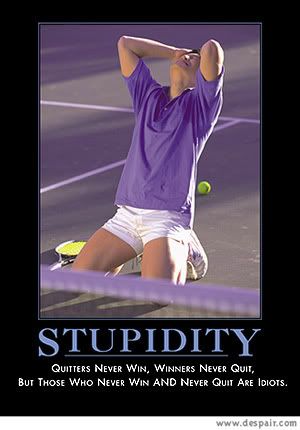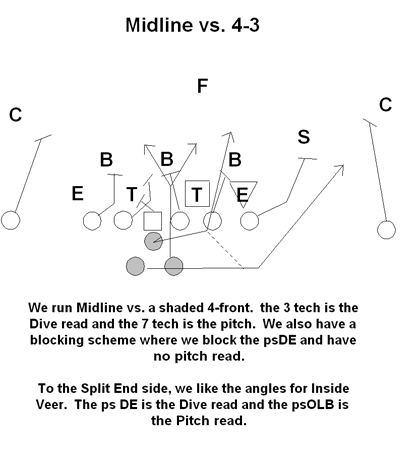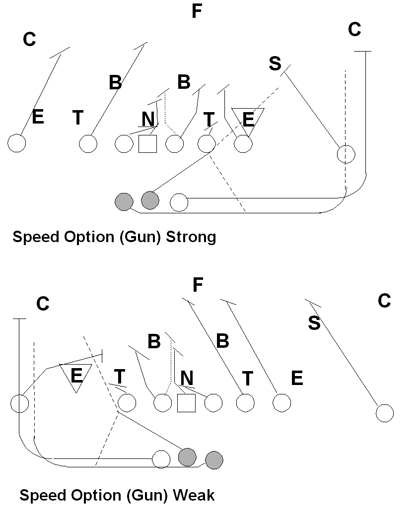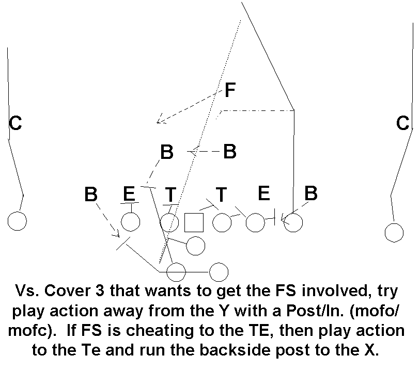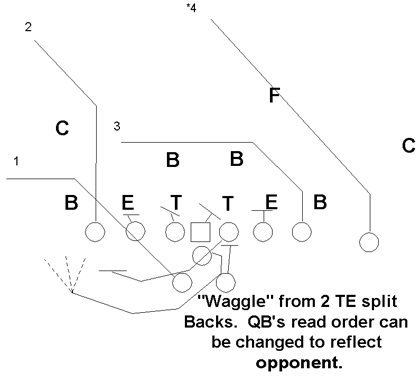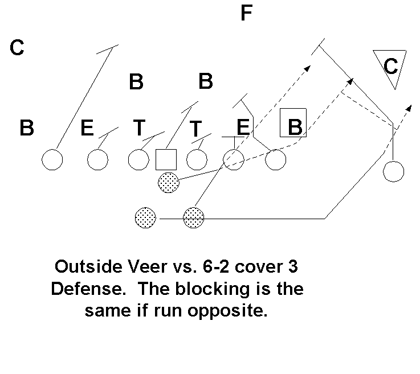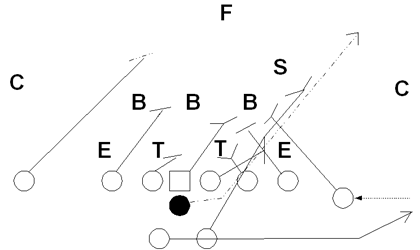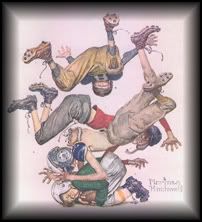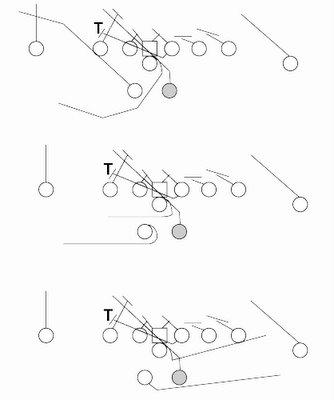While I have been away for the better part of the month, I have been thinking about the next series of articles for Veersite dealing with X's and O's. I am conviced that the next topic at hand will be blocking rules/schemes for the playaction off the veer. I would also like to dabble in 2-back protections and 1-back protection with the other back free releasing into a pattern. So if any of you guys have any ideas- send them in! I am more than glad to give credit to the source of any info I get, and I would love to post complete articles from other coaches if I can get them.
The Great Option Coaches:
Yeoman.... Rice... Osborne... DeBerry...
Yeoman.... Rice... Osborne... DeBerry...



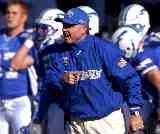
Everyone knows the "biggies..." the coaches who for one reason or the other are icons in the arena of option football. But who are some of the lesser-known coaches who have contributed offensively to this area of football? I know a few coaches in the smaller college ranks that have won or are winning using the option. I know there are many, many more than the few I have heard about. Please submit your recommendations for notable option coaches past and present and I will compile and post the results.
Coach Smith
*** 06 Jan 05 ***
I have had some really great replies to this over on the Rolling Thunder Message Board. Here are some of them:
"Posted by dbayer66 on January 03, 2005 at 08:09:09
In Reply to: The great option coaches... and others posted by Coach Smith on December 31, 2004 at 15:11:40
Pasqualoni and DeLeone at Syracuse. Even though there has been a change there. many agree that their knowledge of the option is incredible. Pasqualoni turned
Western Connecticut State from lowly backwater to NCAA playoff team in four years with the wishbone."
"Posted by ned on January 02, 2005 at 22:53:25
In Reply to: The great option coaches... and others posted by Coach Smith on December 31, 2004 at 15:11:40
A coach From Michigan that many of you have probably never heard of, but is an extrodinary coach! He ran Triple Option out of split back early in his carrear and now mainly out of double Slot. His team this year was Ranked in the USA Today Top 25 and appeared on ESPN. He is also on of the winningest Coaches in MI, one time leading a team to 9 consective undefeated seasons. If you haven't heard of him yet, trust me, you will.
Tony Coaches at Muskegon High School in Muskegon, MI"
"Posted by WRB on December 31, 2004 at 15:49:41
In Reply to: The great option coaches... and others posted by Coach Smith on December 31, 2004 at 15:11:40
I would like to add Royal, Bellard, Bryant, Bud Wilkinson and Missouri's Don Farout. Without Don, would we have option football? Without Wilkinson and his Okie shutting down the Split-T, would we have the powerful split-back veer and mighty wishbone? Come to think of it, without the Okie would the No Fun League have an undefeated Miami team?
I would also like to add AUTHOR Rodgers, Pepper, 1931-
TITLE Installing football's Wishbone T attack, by Pepper Rodgers and Homer Smith.
PUBLISHER West Nyack, N. Y., Parker Pub. Co. [1974, c1973]
DESCRIPTION x, 224 p. illus.
SUBJECT HDNG Football -- Offense.
ADDED AUTH Smith, Homer, joint author.
ISBN 0134677129. OCLC # 934674. LC CONTROL # 74010522.
Rodgers never won the big championship but he did contribute greatly to wishbone option football with his book. I have read this book cover to cover and think it should be reprinted.
WRB"
"Posted by Coach Hec on January 02, 2005 at 15:24:57
In Reply to: Re: The great option coaches... and others posted by Larry C. on January 02, 2005 at 12:51:58
The Great Option Coaches:
Yeoman.... Rice... Osborne... DeBerry... (who am I forgetting??)
How about Georgia Southern's Erk Russell, Texas' Darrell Royal, Alabama's Bear Bryant, and even Oklahoma's Barry Switzer?"
"Posted by Larry C. on January 02, 2005 at 12:51:58
In Reply to: The great option coaches... and others posted by Coach Smith on December 31, 2004 at 15:11:40
Coach Smith,
Many great coaches have been mentioned here. I'd like to add two more: Barry Switzer and Kenny Hatfield. FWIW: Both are Arkansas graduates.
Switzer convinced Chuck Fairbanks to abandon the Houston Veer while he was Fairbank's Off Coord at OU. "Veer was a good rushing offense, but you had to pass the ball.." "We need to be running UT's Wishbone." And the rest is history for Switzer and the Sooners!
Hatfield As many of you know, revived Air Force's program with the Wishbone, before turning it over to Fisher DeBerry. Hatfield went to Arkansas where he won alot of close games, Two SWC championships-and they couldn't stand him! Go figure! By the way, Hatfield ran the "I-Bone" at Ark. He's done a good job at Rice with the Triple option, also; including a stunning 1995 upset of UT in the driving rain in Houston.Sorry for writing a novel!
Respectfully,
Larry C.
PS: let's not forget Paul Johnson!"
"Posted by BLb on January 03, 2005 at 19:19:22
In Reply to: The great option coaches... and others posted by Coach Smith on December 31, 2004 at 15:11:40
Holtz started running the Veer at William and Mary and continued at NC State and Arkansas. Ran 'I' option (and a little "bone" at Minnesota and ND. Wrote two books on the Veer - "The Grass is Greener" while at NC State and "The Offensive Side of Lou Holtz" while at Arkansas. His 31-6 whipping of Oklahoma in the 1978 Orange Bowl running the Veer, after suspending four starters, is still a classic. And of course he won a national championship with Tony Rice running the option and Tim Brown catching the ball (and occasionally a pitch as HB in bone) and returning kicks."
From the Megaclinic Option forum...
"Re: The great option coaches... and others
Author: greg b (---.proxy.aol.com)
Date: 01-03-05 10:17
Wouldn't Coach Larry Beckish have to qualify?
How about ...well, forgot his name. Coached at Wofford and Appalachian state during the 70's.... Brakefield. Really started the flexbone that Hatfield gets credit for. DeBerry was on his staff at each stop before he went to Air Force.
How about the Moore guy who was at Kansas during the mid-70's and used the read belly/double dive.
Pepper Rogers.
Charley Taffe.
Emory Bellard.
DeMeo.
Pasquloni/Deleone (Syracuse)
Paul Johnson
Stowers
Greg B"
"Author: Panther98 (---.fwcs.k12.in.us)
Date: 01-03-05 13:50
Farley---University of Wisconsin at River Falls"
"Author: rlw34 (205.204.242.---)
Date: 01-06-05 08:46
im glad someone mentioned johnson at navy. i also think mike sewak at georgia southern is a good one. also, i must mention a little know coach, ivan jasper. he is the qb coach at navy and does an outstanding job teaching the triple."




